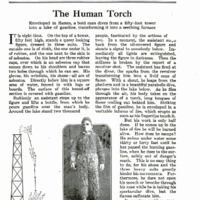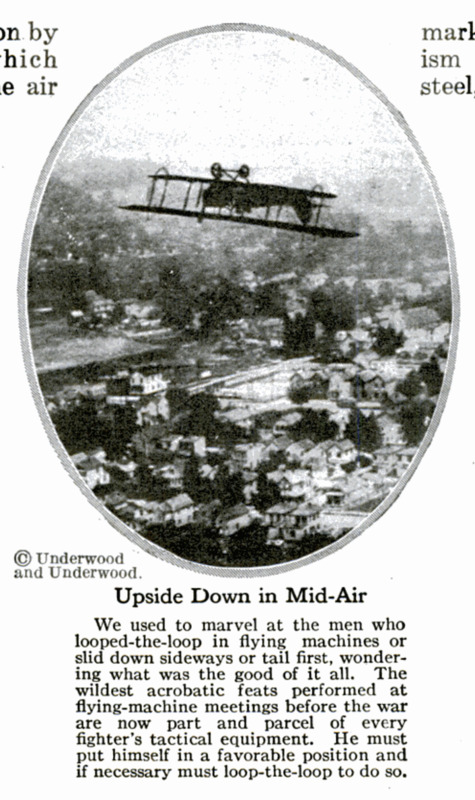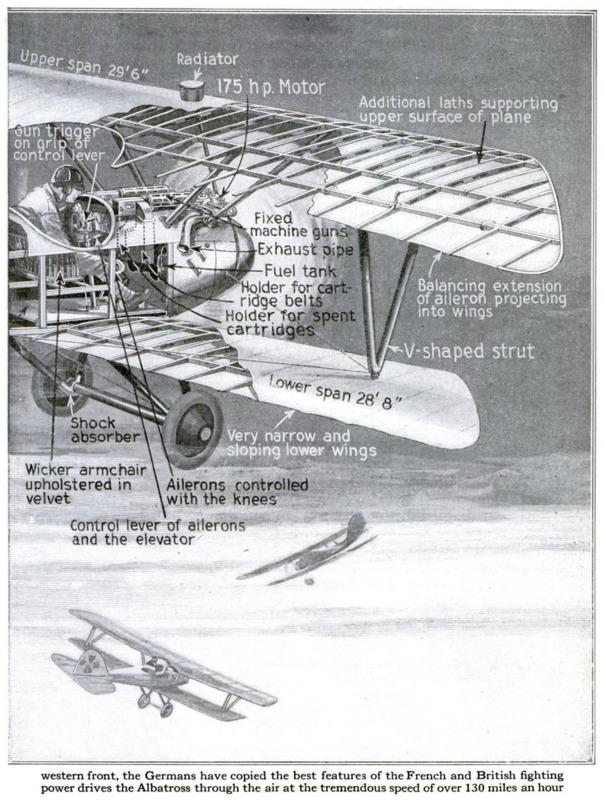-
Title (Dublin Core)
-
German Albatross Destroyer
-
Article Title and/or Image Caption (Dublin Core)
-
Like a Wasp on the Wing
-
Caption 1: Upside Down in Mid-Air. We used to marvel at the men who looped-the-loop in flying machines or slid down sideways or tail first, wondering what was the good of it all. The wildest acrobatic feats performed at flying-machine meetings before the war are now part and parcel of every fighter's tactical equipment. He must put himself in a favorable position and if necessary must loop-the-loop to do so.
-
Caption 2: In their new Alabatross destroyer, which is probably the fastest fighting machine on the western front, the Germans have copied the best features of the French and British fighting machines and have added improvements of their own. A stationary engine of 175 horse-power drives the Albatross through the air at the tremendous speed of over 130 miles an hour
-
extracted text (Extract Text)
-
THE war will be won by |
that power which |
launches into the air
the greatest number
of the fastest fighting
airplanes. This seems
to have been realized
from the day when it
dawned on the general
staffs of Europe that
artillery must be aim-
ed by a man several
thousand feet in the
air, that the enemy
must be prevented
from similarly direct-
ing his own fire, and
that as a result, fight-
ing machines must be
resorted to in order
to gain supremacy in
the air. As a result,
the warring nations
have been trying to
outstrip one another
in producing the fast-
est and most formida-
ble fighters. British,
French, Germans
have all commanded the air at different
times, and the times usually coincided
with the appearance of faster and more
improved machines.
‘Whenever the newest type of hostile
machine is captured, it is examined with
microscopic minuteness. The curve of
its wings, the spacing of its struts, the
shape of its fins and tail, the material of
which it is made, the proportioning of its
different parts—everything is measured,
tested and noted. It is not only studied;
it is copied. This is no time for riding
pet hobbies. The best that the enemy has
must be not only imitated, but bettered.
It seems to be conceded in the British
and French despatches that the new
German Albatross destroyer known as
“type D-III” is for the time being the
fastest and most formidable fighting
airplane on the Western front. In this re-
markable piece of mechan-
ism we see embodied in
steel, wood and linen, all the
lessons so bloodily
driven home by two
years of fighting in the
air. The new Alba-
tross is an amalgama-
tion of the best fea-
tures to be found in
the original small Al-
batross and the latest
fast French Nieuport.
Above all things, a
fighting machine must
be fast. A speed of
one hundred and thir-
ty miles an hour is
about the minimum
now. In addition to
speed, the machine
must have the maneu-
vering power of a
wasp; it must be
able to dart up and
down and in and out
with the rapidity of
an insect.
In the French Nieu-
port machine these two essential qualities
of speed and maneuvering ability were
more highly developed than in any other.
The Nieuport is a biplane in which the
lower wing is but half as wide as the
upper. We look at the Albatross. Sure
enough, its lower wing is one-half the
width of the upper. In the fast Nieuport,
the wings are “staggered”—that is, the
lower wing lies not directly below the
upper, but slightly to the rear, so that the
front edge of the lower wing is just be-
neath the rear edge of the upper one.
Why is this done? Because the struts
that tie the two wings together can be
shortened. Shortened struts, in turn,
mean less wind resistance. Look at the
detail drawing of the Albatross that ac-
companies this article. You see at once
that the Albatross, too, has “staggered”
wings and short struts.
‘Why is the lower wing narrower than
the upper? There is a kind of interference
between upper and lower wings. The air
is ‘“‘caught,” as it were, between the
superposed surfaces. 1f the lower wing is
narrowed this interference is largely pre-
vented. But there are structural reasons,
too, for narrowing the width of the lower
plane. Note in the drawing that the
struts are triangular in form and that the
rear member of a triangle lies directly
behind the front member. Isn't it obvious
that the triangular strut thus formed is
strong and light and that it will offer less
resistance to the wind than if a rectangle
with diagonal wire bracing were adopted?
Note, too, that the staggered wing con-
struction with the narrow lower plane
makes it possible to fasten each triangular
strut directly to the lower main beam.
This adds to the strength of the entire biplane.
But the Germans have improved upon
the Nieuport in this: They have spread
the central struts which hold the upper
wing to the fuselage or body, far apart.
Hence the two wings are tied together by
only two sets of struts—the triangular
ones previously described and the central
ones. Why was this done? Simply to
avoid the use of wires. In the older ma-
chines, by which I mean machines that
flew in the early weeks of the war, there
were a far greater number of wires than
would now be considered permissible.
Wire bracing extended in all directions.
Now, a piano wire which vibrates a
distance of half an inch to either side of
its normal position offers as much re-
sistance as a rod one inch in diameter. A
wire may seem thin, but when it vibrates
it is the equivalent of a thick rod. It
offers much resistance as a result. And
s0 we find the airplane designers of the
world trying to get rid of wires. The
builders of the Albatross have gone far
in this direction.
From the British, the Germans copied
the rounded outline of the tail fins. The
tail surfaces of a flying machine have
much the same effect as the feathers of an
arrow. They steady the machine. The
perfect target arrow has rounded feathers.
This explains the British tail formation
of the German Albatross.
More than any other fighting machine
thus far designed the Albatross is shorn
of projections. Indeed, the craft ap-
proaches a bird in cleanness of line. The
water tank, for instance, is no longer
found near the engine; it is built into the
upper wing. The radiators, through
which the cooling water circulates, lie
flat against the fuselage or body.
Steadying fins and rudders and ailerons
(the hinged surfaces at the rear corners of
the upper wing, serving to balance the
machine from side to side) must be strong
and stiff and yet free from external sup-
port. But their wind resistance must be
low. The Germans met the situation
by giving the fins and rudders a stream-
line form, which means a shape that parts
the air most easily. The steadying effect
of a fin depends in part on its area.
Additional area was gained very cheaply
by filling out the space between the fuse-
lage or body and the tail-skid.
The fuselage or body in which the single
fighter sits is noticeably large. But mark
the lines. This smooth, correctly de-
signed bulk, large as it is, parts the
air with the lowest possible resistance.
Note how the fuselage and the wings
are tied together so as to get rid
of struts and wires. The idea is not new,
but it has been so ingeniously carried out
that it deserves mention here.
The exhaust from the engine is care-
fully collected and conducted downward
and rearward. Whiffs of exhaust gas
should not be added to the tribulations
the pilot already has to bear.
It takes a certain amount of muscular
effort to swing a rudder quickly. Clearly,
the fighter who can swing his rudder most
quickly has the greatest maneuvering
ability. The muscular effort involved,
must not retard a man from making the
right turn at the right moment. Hence
we find that in the Albatross all the con-
trolled surfaces are balanced, which means
that triangular extensions are provided
beyond their pivots. You will find this
clearly brought out in the tail of the
Albatross as it is shown in the accompany- *
ing drawing.
Since the entire machine must be swung
around in order to aim a gun, it is obvious
that as many as twelve guns could be
mounted if there were place for them.
Indeed, on the Nieuport as many as five
have been carried—three on the upper
‘wing and two firing through the propeller.
No doubt a similar practice is followed
by the Germans. In our drawing we have
shown only two machine guns firing
through the propeller.
How astonishing it is to find the in-
ventions of fairy-tale writers brought to
realization. For years we have been en-
tertaining our children with one of the
most beautiful fairy-tales of Hans Chris-
tian Anderson—a tale in which a wicked
prince rashly essays to fight God himself
with ships flying through the air and
mounting guns that rain thousands of
bullets in response to the mere pressing
of a button. Look at the Albatross and
you will see the magical buttons attached
to the control-lever. Who knows but
flying machine designers may find other
improvements suggested in what we have
been pleased to consider the poetic
vaporings of romancers!
-
Contributor (Dublin Core)
-
Carl Dienstbach (writer)
-
Underwood and Underwood (photo)
-
Language (Dublin Core)
-
eng
-
Date Issued (Dublin Core)
-
1918-01
-
pages (Bibliographic Ontology)
-
55-58
-
Rights (Dublin Core)
-
Public Domain (Google digitized)
-
References (Dublin Core)
-
Europe
-
Archived by (Dublin Core)
-
Filippo Valle
-
Alberto Bordignon (Supervisor)
 Popular Science Monthly, v. 92, n. 1, 1918
Popular Science Monthly, v. 92, n. 1, 1918







